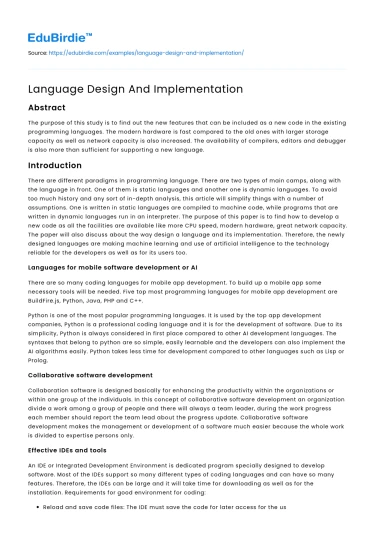Introduction
The design and implementation of programming languages are pivotal to advancing computer science and enhancing software development. Programming languages serve as the medium through which developers express computational ideas and communicate with machines. Over the decades, the evolution of languages has been driven by a need to improve efficiency, readability, and expressiveness. This essay explores the intricacies involved in language design and implementation, examining how different paradigms and methodologies have shaped modern programming languages. It also addresses the challenges and counter-arguments in the field, providing a comprehensive understanding of how these languages are crafted and evolved to meet contemporary needs.
By analyzing historical contexts and real-world applications, this essay aims to highlight the critical aspects that influence language creation. Furthermore, it delves into the balance between innovation and backward compatibility, a recurring theme that influences language developers' decisions. As technology rapidly progresses, understanding these aspects becomes increasingly crucial for developers and researchers alike.
Save your time!
We can take care of your essay
- Proper editing and formatting
- Free revision, title page, and bibliography
- Flexible prices and money-back guarantee
The Evolution of Programming Languages
The evolution of programming languages is marked by significant milestones that reflect shifts in computing paradigms. Early languages, such as Assembly and Fortran, were designed with efficiency in mind, targeting the hardware constraints of the time. As noted by Sebesta (2016), "the primary goal of early languages was to efficiently translate human instructions into machine code" (p. 35). This efficiency often came at the cost of readability and maintainability, issues that later languages sought to address. For instance, the introduction of structured programming languages like C and Pascal in the 1970s allowed developers to write more modular and comprehensible code.
The 1990s and 2000s saw a shift towards object-oriented programming (OOP) with languages such as Java and C++. OOP provided developers with powerful abstractions for modeling real-world entities and relationships, greatly enhancing code reuse and scalability. However, this paradigm was not without its critics. Some argued that OOP's emphasis on inheritance and polymorphism could lead to overly complex hierarchies (Stefik & Siebert, 2013). Despite these criticisms, OOP remains a dominant paradigm, underscoring the importance of balancing innovation with practical applicability.
In recent years, functional programming languages like Haskell and Scala have gained traction, driven by the rise of concurrent and distributed computing. These languages offer immutable data structures and first-class functions, promoting a declarative style that simplifies reasoning about code behavior. According to Thompson (2011), "functional programming provides powerful tools for tackling parallelism, a critical requirement in modern software systems" (p. 76). This evolution highlights the ongoing quest to create languages that facilitate efficient, reliable, and maintainable software development.
Challenges in Language Design and Implementation
Designing a programming language involves a myriad of challenges, from defining syntax and semantics to ensuring efficient implementation. One of the primary challenges is achieving a balance between simplicity and expressiveness. A language that is too simplistic may fail to provide the necessary constructs for solving complex problems, while an overly expressive language can become cumbersome and difficult to learn. As Stroustrup (2013) notes, "the art of language design is in finding a balance between expressive power and simplicity" (p. 94). This balance is crucial for a language's adoption and longevity.
Another significant challenge is maintaining backward compatibility while introducing new features. Developers often rely on existing codebases, and breaking changes can lead to significant migration costs. For example, the transition from Python 2 to Python 3 introduced several breaking changes, causing adoption delays despite Python 3's improvements. Language designers must carefully weigh the benefits of new features against the potential disruption to existing users.
Furthermore, the implementation of a language involves optimizing for performance across various platforms. This requires a deep understanding of compiler design and runtime systems. Compiler optimizations, such as just-in-time compilation, have become essential for languages like JavaScript, which powers complex web applications. As Aho, Lam, Sethi, and Ullman (2006) state, "efficient language implementation is as critical as the language design itself" (p. 112). These challenges underscore the complexity of language design and the need for a multidisciplinary approach.
Future Directions and Conclusion
The future of programming languages will likely be shaped by emerging technologies and evolving developer needs. As artificial intelligence and machine learning become more prevalent, languages that facilitate these domains, such as Python and R, are expected to gain prominence. Additionally, the increasing importance of security and privacy in software systems will drive the development of languages that incorporate robust safety features.
In conclusion, the design and implementation of programming languages are dynamic processes that reflect broader shifts in technology and software development practices. While historical trends provide valuable insights, ongoing innovation is crucial for addressing the challenges posed by new computing paradigms. By balancing expressiveness, simplicity, and compatibility, language designers can create tools that empower developers to tackle complex problems efficiently. As the landscape of computing continues to evolve, the principles of language design and implementation will remain a fundamental area of research and development.
Understanding these principles is not only vital for language creators but also for developers who must navigate an ever-changing ecosystem of languages and tools. By appreciating the complexities and trade-offs involved, stakeholders can make informed decisions that drive the future of software development.






 Stuck on your essay?
Stuck on your essay?

